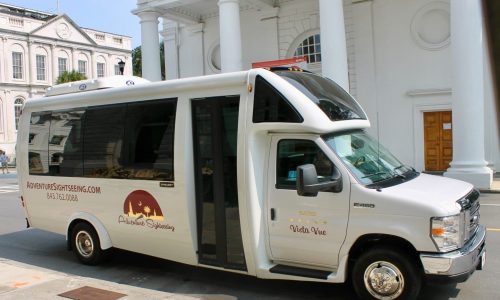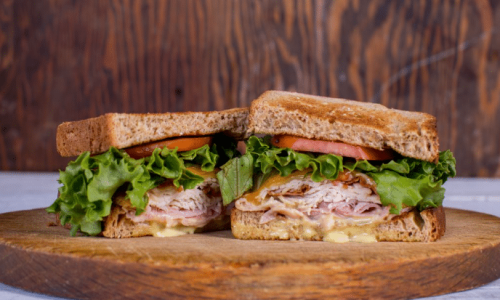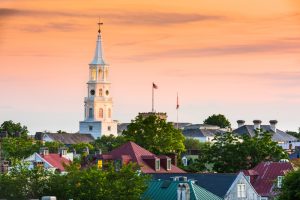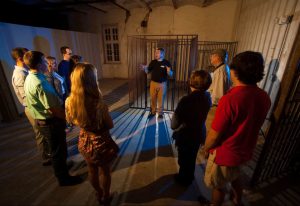
Charleston is most certainly a city by the sea. From the Civil War-era forts in the harbor to the port as a center for trade, Charleston’s history and economy are anchored in the water that borders the city. Rice and indigo trades flourished in the 18th century, bringing the city significant wealth and prominence. When the first shots of the Civil War were fired in Charleston’s harbor, the city took on a pivotal role in the war.
According to historic accounts, Charleston was an open port for blockade runners during the Civil War. Organized by locals, the port was a lifeline for the Confederacy in need of war supplies and materials from overseas. But the Confederacy’s defeat in the Civil War hit Charleston hard in the mid-1860s and the city began a long economic decline. Commercial ships had been destroyed in the war and ocean commerce was virtually non-existent, according to information from “The City of Charleston Tour Guide Training Manual.” As a result, the city’s docks fell into disrepair.
It wasn’t until 1942 when the S.C. State Ports Authority was established to support World War II efforts that the city’s waterfront saw new life. Today the Ports Authority operates terminals in Charleston and Georgetown. Last year, those terminals served more than 1,800 ships. The Port of Charleston is one of the busiest container ports along the Southeast and Gulf coasts. The Charleston Customs district ranks as the nation’s eighth largest in terms of the dollar value of international shipments, with cargo valued at more than $63.6 billion in 2012.
So learning about Charleston’s historic harbor is almost a requirement on any trip to Charleston. Visit Fort Sumter, stroll the bridge over the Cooper River for a bird’s eye view of the bustling port or simply relax and watch the dolphins play in these historic waters.
FORT SUMTER
Fort Sumter National Monument is not only an interesting tourist attraction in the middle of the harbor, but a pivotal piece of American history. Confederate forces fired the first shots of the Civil War at Federal troops at Fort Sumter at 4:30 a.m. on April 12, 1861. Fort Sumter surrendered 34 hours later. Throughout the war’s duration, Fort Sumter would play an important role as Union forces spent nearly four years trying to take it back.
Visitors can reach Fort Sumter by private boat or a tour boat via Fort Sumter Tours. A number of tour departure times are available from two locations: Liberty Square in downtown Charleston or Patriots Point in Mount Pleasant. Visitors take a 30-minute narrated cruise to Fort Sumter where National Park Service rangers provide more information about Fort Sumter and its role in the Civil War. The site has a museum filled with historic artifacts as well as a souvenir shop. Fort Sumter National Monument has one of the best collections of 19th-century seacoast artillery anywhere in the United States. In addition to the regularly scheduled tours, take a Sunset Tour of Fort Sumter each Friday evening through October. Tours depart at 5:15 p.m. from Liberty Square with a one-hour visit to Fort Sumter and an extended cruise back to downtown Charleston while enjoying the evening sunset over the city.

USS YORKTOWN
Part of Patriots Point Naval and Maritime Museum, the USS Yorktown is a commanding presence in the Charleston harbor and a visible reminder of Charleston’s role in historical events and wars. The USS Yorktown was the 10th aircraft carrier to serve in the U.S. Navy. Visitors have quite a bit of ground to cover as the ship stretches to almost 900 feet. Weighing 27,000 tons, it’s a massive ship; yet crews built the Yorktown in less than 17 months at Newport News, Va. Commissioned on April 15, 1943, the Yorktown played a significant role in the Pacific Offensive that began in late 1943 and ended with the defeat of Japan in 1945. Patriots Point is also home to the USS Laffey, which supported the D-Day landings at Normandy and participated in the U.S. offensive against Japan, along with the USS Clamagore, a submarine used for 30 years during the Cold War. Patriots Point in Mount Pleasant is open daily from 9 a.m. to 6:30 p.m.
ARTHUR RAVENEL JR. BRIDGE
Maybe only next to the Battery and Rainbow Row, this bridge is quite possibly one of the most photographed structures in Charleston. Opened in summer 2005, the bridge has become a Charleston icon, showing up quite regularly in Instagram feeds in all its sunrise, sunset and sunny day glory. The bridge replaced two narrow and aging bridges – the John P. Grace Memorial and Silas N. Pearman – that simply couldn’t keep pace with the area’s population growth. The new bridge was constructed with two

diamond towers reaching heights of 575 feet, and the bridge itself is more than 13,000 feet in length. The design and construction took almost four years and came with a $632 million price tag. The bridge is named for Arthur Ravenel Jr., a South Carolina senator and then Congressional representative. In 1996, he was elected again as a senator and his platform included securing funding for a new Cooper River bridge. One of the bridge’s key features is its pedestrian/bike lane that is used year-round by locals and visitors.
FORT MOULTRIE
Fort Moultrie is the only unit of the National Park System where the entire 171-year history of American seacoast defense can be traced. Five sections of the Sullivan’s Island fort and two outlying areas represent a different historical period in the life of the three Fort Moultries. The first fort fell into disrepair while the second fort was destroyed in an 1804 hurricane. In 1809, a third Fort Moultrie was constructed and remained virtually untouched until 1860 and the Civil War. Then in the 1870s, Fort Moultrie was modernized with a new cannon as well as bombproofs that were made of thick concrete and then buried under tons of earth to absorb the explosion of heavy shells. Fort Moultrie is open to visitors daily except for New Year’s Day, Thanksgiving and Christmas.
Where to snap a good photo of the Charleston harbor:
- The Battery – Walk along this historic seawall for views of the Charleston harbor and even Fort Sumter and Fort Moultrie. Look to the other side of the Battery to see rows of antebellum homes and historic mansions. Also along East Bay Street is White Point Gardens, first a public garden in 1837 and then a Civil War fortification for the city. Today it’s a public park with a Confederate monument and historic cannon displays.
- Waterfront Park – Located at the corner of Vendue Range and Concord streets, Waterfront Park is beloved among visitors and locals alike. Park benches and family size swings are great places to sit and soak in the views of the harbor or walk the length of the pier for a terrific view of the bridge over the Cooper River, the USS Yorktown and, quite often, dolphins playing in the water.
- Deck of the South Carolina Aquarium – If you’re planning a visit to the aquarium, make sure to allot some time on the decks that line the Cooper River. It’s a great place to watch boats and ships or catch a glimpse of some dolphins swimming.
While you’re out and about enjoying the Charleston harbor, snap a photo and enter our #MyCharlestonPic photo contest. Simply use the hashtag #MyCharlestonPic and tag us on Twitter or Instagram or post the photo on our Facebook page. We’ll pick one of the best photos to publish in the summer issue of Traveler of Charleston.




















